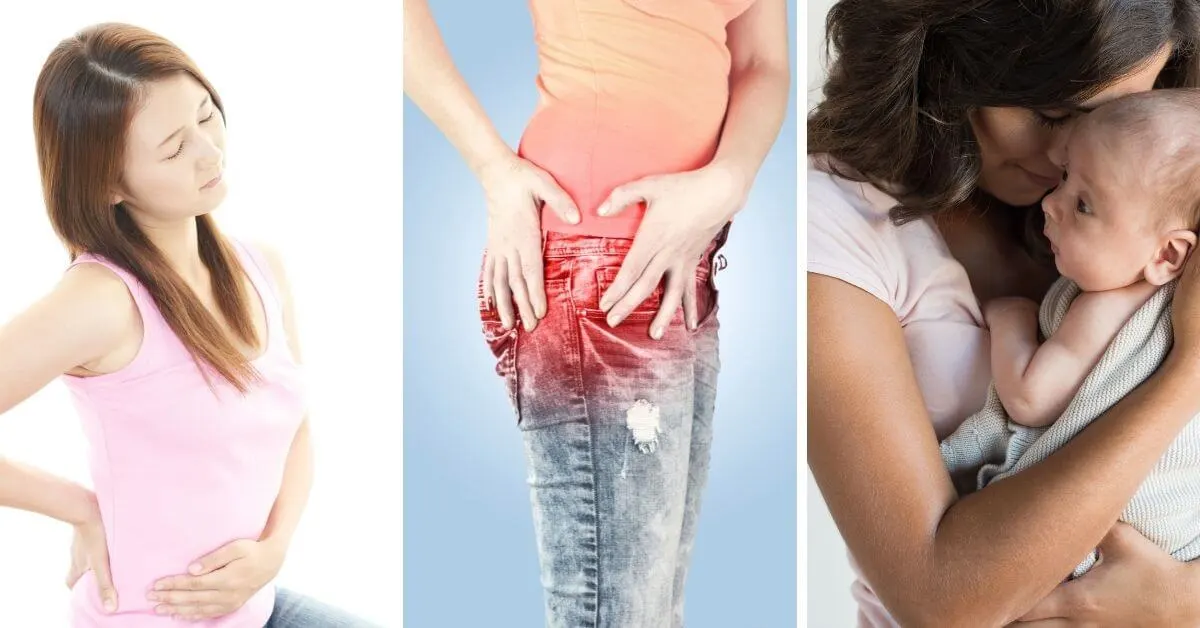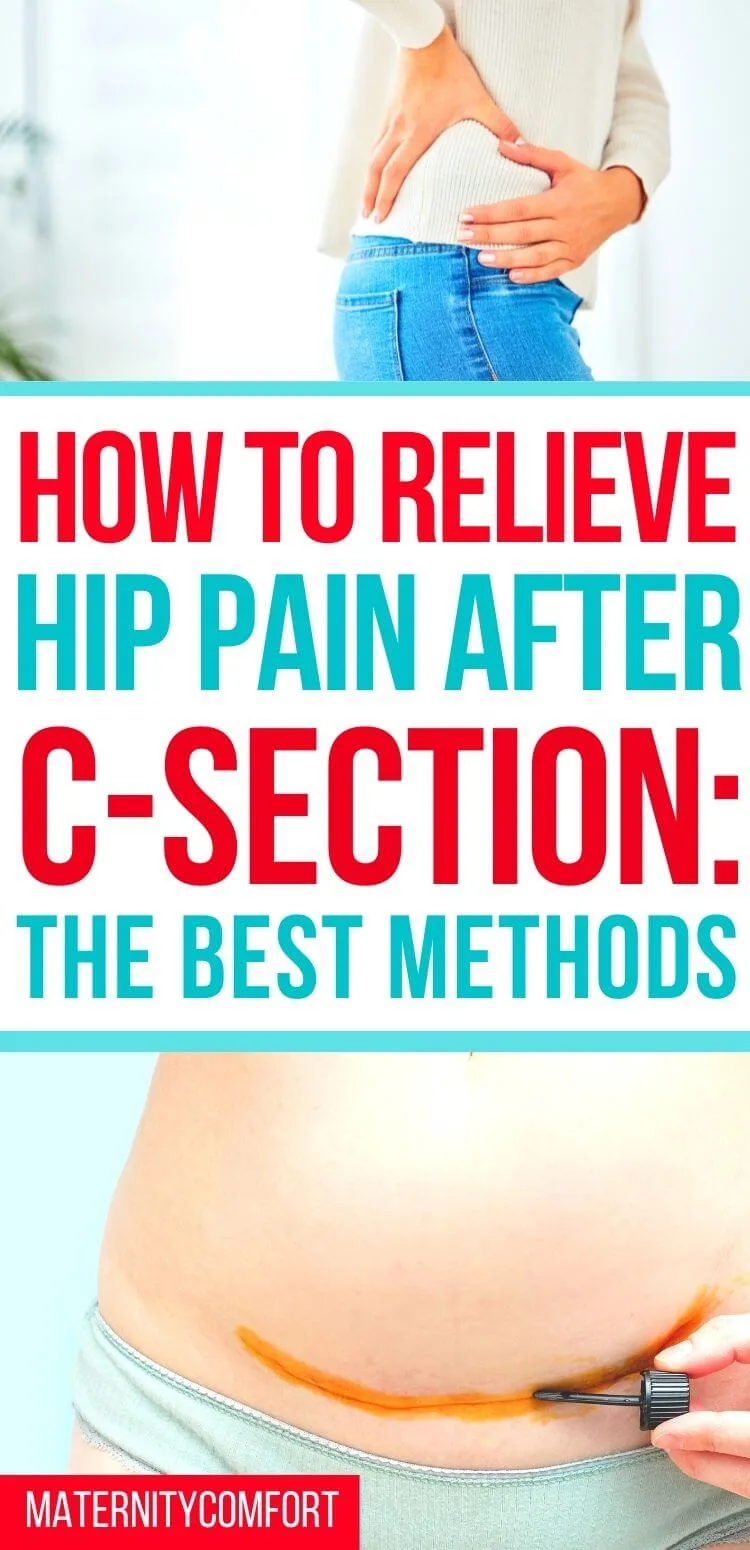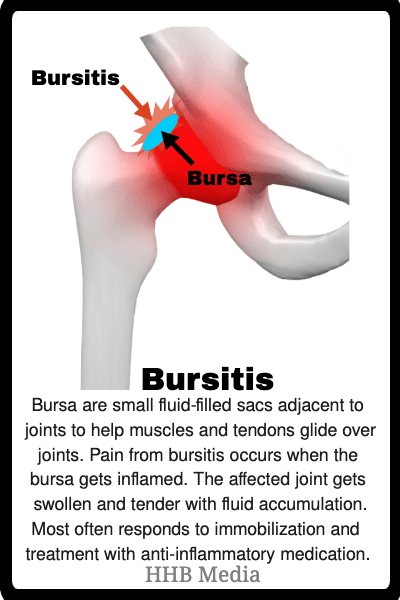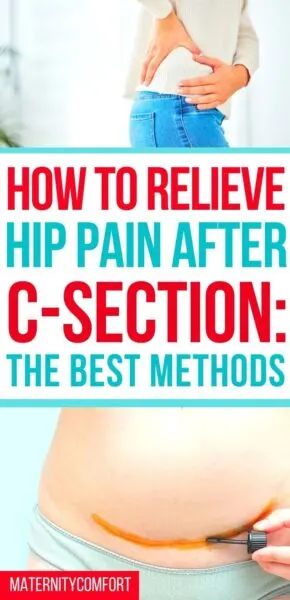Updated October 25, 2023
If you’re experiencing hip pain after pregnancy c-section, you’re not alone.
Many women experience hip pain in the weeks and months after giving birth.
This can be a frustrating experience, especially if you’re not sure what’s causing the pain.
In this blog post, we’ll discuss the causes of hip pain after a c-section and offer some solutions to help relieve the pain.

If you experience long-term pain after c-section this may or may not be related to having had a c section.
To determine the cause of the hip pain, it is important to look at all the factors that can cause hip pain including before, during, and after your pregnancy.
As with any medical condition that can have more than one cause, experiencing hip pain after childbirth needs to take into account your past medical history, potential problems during your prenatal course, and the events relating to your labor and delivery.

Since all new moms do not experience hip pain after childbirth, it is important to rule out preexisting medical conditions that could have been exacerbated as a result of their pregnancy.
It is also important to factor in any history of pelvic pain or pelvic girdle pain that could be contributing to the problem.
This could be the result of endometriosis, scar tissue, or other causes of chronic pelvic pain.
How to Relieve Hip Pain After Pregnancy C-Section
Causes of hip pain after a c-section:
1. Bursitis – Bursitis is inflammation of the capsule around a joint. When the hip joint gets inflamed the pain can be severe and though it will most often resolve, there is often a need for treatment to get the inflammation to settle down. Childbirth involves a lot of leg manipulation (especially during the pushing phase of labor) and this could lead to bursitis. If there was no second stage of labor it is less likely one would experience hip bursitis after c-section.

2. Sciatic pain (nerve entrapment) – when the sciatic nerve is impinged upon by pressure as it courses through the pelvis it can cause pain. Sciatic nerve compression can cause a burning sensation. So burning hip pain after c-section delivery can occur; however, this can be from a vaginal delivery as well. In fact, most sciatic pain occurs during pregnancy even prior to delivery as the sacroiliac joints loosen to prepare for childbirth.

3. Arthritis – If there is a history of degenerative arthritis, rheumatoid arthritis, psoriatic arthritis, etc., childbirth (either vaginally or by cesarean section) could cause these conditions to flare up.
4. Traumatic Injury to the hip or pelvis such as a prior motor vehicle accident or sports injury could result in hip pain or low back pain after childbirth.
5. Position changes during childbirth can be extreme when the legs are flexed back. With anesthesia, the pain from manipulation of the legs may not be present until the anesthesia has worn off. This hyperflexion of the legs is done to allow the delivery of the newborn’s head under the pubic bone. If this was to be considered a possible cause of hip pain relating to a c-section it would mean there was an attempt at the second stage of delivery prior to performing a c-section. If the hip pain is related to labor, it is also possible to have isolated right or left side hip pain after c-section.
6. Anesthesia or Nerve blocks could cause localized pain but is not common. It would likely be considered once other causes have been ruled out. If your problem is severe, the labor and delivery anesthesia staff are available to consult with you about your management during your delivery and evaluate your hip pain symptoms.
Solutions: how can you relieve hip pain after a pregnancy c-section?
One of the most common causes of hip pain after a c-section is due to the position you’re in during the surgery.
When you have a c-section, you’re typically lying on your back with your legs pulled up and apart.
This can put a lot of strain on your hips and cause them to become painful.
Additionally, the anesthesia can also contribute to hip pain after a c-section.
The anesthesia can cause your muscles to relax and this can lead to joint and muscle pain.
There are several things you can do to relieve hip pain after pregnancy c-section.
One of the best things you can do is get moving as soon as possible after your surgery.
Walking is a great way to get your hips moving and help reduce pain.
You can also try doing some gentle stretching exercises to help loosen up your hips.
10 exercises to relieve hip pain after pregnancy c-section
1. Hip Circles:
Stand with your feet hip-width apart and place your hands on your hips. Make sure your shoulders are down and relaxed. Gently circle your hips in a clockwise direction for 20 seconds. Repeat in the counterclockwise direction.
2. Hip Hikes:
Stand with your feet hip-width apart and place your hands on your hips. Keeping your left leg straight, lift your right leg up as high as you can. Return to the starting position and repeat with the left leg. Do 15 reps on each side.
3. Fire Hydrants:
Start on all fours with your hands under your shoulders and your knees under your hips. Keeping your left knee bent, lift your left leg up to the side until it is in line with your hip. Return to the starting position and repeat with the right leg. Do 15 reps on each side.
4. Hip Bridges:
Lie on your back with your feet flat on the ground and your knees bent. Place a foam roller under your right hip. Keeping your right foot flat on the ground, lift your hips up until they are in line with your shoulders, and then lower them back down. Repeat 15 times and then switch sides.
5. Hip Flexor Stretch:
Start in a lunge position with your right leg forward and your left leg back. Shift your weight onto your right leg and place your left hand on your right knee. Keeping your core engaged, lean forward until you feel a stretch in the front of your left hip. Hold for 30 seconds and then repeat on the other side.
6. Pigeon Pose:
Start on all fours with your hands under your shoulders and your knees under your hips. Bring your right knee forward and place it behind your right wrist. Slowly lower your hips to the ground and slide your left leg back until you feel a stretch in the front of your left hip. Hold for 30 seconds and then repeat on the other side.
7. Hip Rotations:
Lie on your back with your knees bent and feet flat on the ground. Place your right hand on your right knee and use your left hand to pull your right knee across your body towards the left shoulder. Hold for 30 seconds and then repeat on the other side.
8. Figure Four Stretch:
Lie on your back with both knees bent and feet flat on the ground. Place your right ankle on top of your left knee. Use your left hand to grab your right thigh and pull it towards you. Hold for 30 seconds and then repeat on the other side.
9. Seated Hip Stretch:
Sit on the ground with your legs extended in front of you. Bend your right knee and place your right ankle on top of your left thigh. Use both hands to grab your left thigh and pull it towards you. Hold for 30 seconds and then repeat on the other side.
10. Cat-Cow Pose:
Start on all fours with your hands under your shoulders and your knees under your hips. As you inhale, arch your back and look up towards the ceiling. As you exhale, round your back and tuck your chin to your chest. Repeat this movement for 30 seconds.
Note: If you experienced a separation of the abdominal muscles as a result of your pregnancy (also known as diastasis rectus), you will want to make sure your postpartum condition is ready for the exercises listed above.
It might be determined that in order to do the exercises, you should wear an abdominal binder to reduce the stress on your abdominal wall.
A binder will also result in better stability when on your feet.
This is because the binder helps support the abdominal core muscles.
Additionally:
- If you’re breastfeeding, you can try using a support pillow to help take some of the pressure off of your hips.
- over-the-counter pain medications can also be helpful in relieving hip pain after pregnancy c-section.
- try icing the area for 20 minutes several times a day.
If you’re still experiencing hip pain after trying these solutions, it’s important to talk to your doctor.
They can help identify any other underlying causes of your pain and offer additional treatment and pain relief.
Hip pain after a c-section is common but it doesn’t have to be a part of your postpartum experience.
With the right treatment, you can often find relief and get back to enjoying your new baby.
FAQ about hip pain after pregnancy c-section
Can C-section cause hip pain?
C-sections can sometimes cause hip pain because of the position you’re in during surgery.
Hip pain is also common after C-section due to the strain that’s placed on your hips during pregnancy and delivery.
However, hip pain can also be caused by other factors such as breastfeeding, recovery from surgery, or simply sleeping in an uncomfortable position.
How long does hip pain last after C-section?
Hip pain after C-section is usually temporary and will go away within a few weeks with home treatment.
However, if your hip pain persists or gets worse, it’s important to talk to your doctor so other underlying causes can be ruled out.
Don’t be afraid to speak to your doctor and ask for something for pain relief.
Searing hip pain after a c-section can impact your ability to sleep and care for your newborn.
If your doctor or midwife brushes off your pain, go see someone else, especially if you tried all of these at-home pain relief methods.
Chronic pain after a c-section is not normal and treatments are available.
This may include medications or physical therapy.
What are some home remedies for hip pain after pregnancy c-section?
There are a few things you can do at home to help relieve hip pain after C-section.
First, try icing the area for 20 minutes several times a day.
You can also take over-the-counter pain medication such as ibuprofen or acetaminophen.
Additionally, stretching and massaging the area can also be helpful.
Finally, make sure you’re sleeping on your side with a pillow between your knees to take some of the pressure off of your hips.
How do I know if my hip pain after pregnancy c-section is considered normal?
If you’re experiencing mild hip pain that goes away with home treatment, it’s likely normal and nothing to worry about.
However, if you are having long-term pain after a c-section lasting longer than a few weeks, or is getting worse over time, it’s important to talk to your doctor to try and determine the underlying cause and treatment options.
How long does it take a woman’s body to fully recover from C-section?
It usually takes about six to eight weeks for a woman’s body to fully recover from a C-section.
However, every woman is different and some may take longer to heal than others.
What are the long-term side effects of a c section?
The long-term side effects of a C-section are usually minimal.
However, some women may experience ongoing pain in the scar area or difficulty urinating.
Additionally, some women may have a higher risk of developing blood clots or problems with their bowel function.
If you’re concerned about any long-term side effects, talk to your doctor.
They can offer more information and help you manage any concerns you may have.
Hip pain after c section is common but there are things that can be done to ease the discomfort.
Final Thoughts
If you found this article helpful, please share it with other moms who may be experiencing hip pain after pregnancy c-section.
Hip pain is a common problem but it doesn’t have to ruin your postpartum experience as most causes will spontaneously resolve or with the use of simple supportive measures.
Clearly, if the pain persists for months or you are experiencing hip pain 2 years after c-section, then looking for an underlying cause from the list above is necessary.
With the right treatment, you can get relief and enjoy this special postpartum time with your new baby.
Thanks for reading!



